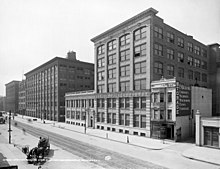George Eastman
With interests in improving health, he provided funds for clinics in London and other European cities to serve low-income residents.
[3] He has been commemorated on several college campuses and the Hollywood Walk of Fame, and the George Eastman Museum has been designated a National Historic Landmark.
[5] In the early 1840s his father had started a business school, the Eastman Commercial College in Rochester, New York.
As Eastman began to have success with his photography business, he vowed to repay his mother for the hardships she had endured in raising him.
[8] Around the same time, he began experiments to create a flexible film roll that could replace plates altogether.
[11][12] The separation of photo-taking from the difficult process of film development was novel and made photography more accessible to amateurs than ever before, and the camera was immediately popular with the public.
By providing quality and affordable film to every camera manufacturer, Kodak managed to turn competitors into de facto business partners.
[18] A number of patent infringement lawsuits would preoccupy Eastman and his lawyers in subsequent years, including one from Reichenbach after he was fired in 1892.
Inventor Hannibal Goodwin had filed a patent for nitrocellulose film in 1887, prior to Eastman and Reichenbach's, but it was not granted until 1898.
[22] As Kodak pursued a monopoly on film through patents and acquisitions, the company experienced rapid growth.
By 1896, Kodak was the leading supplier of film stock internationally,[14] and by 1915, the company was the largest employer in Rochester, with over 8,000 employees and annual earnings of $15.7 Million.
[24] His monopolistic actions attracted the attention of the federal government, which began an anti-trust investigation into Kodak in 1911 for exclusive contracts, acquisitions of competitors, and price-fixing.
[29] During World War I, Eastman established a photographic school in Rochester to train pilots for aerial reconnaissance.
Almost pathologically concerned with decorum, he found himself, for the first time, unable to control his emotions in the presence of his friends.
On September 4, 1922, he opened the Eastman Theatre in Rochester, which included a chamber-music hall, Kilbourn Theater, dedicated to his mother's memory.
[34] In 1915, Eastman founded the Bureau of Municipal Research in Rochester to gather information and make government policy recommendations.
[35] In 1924, Eastman and the Bureau supported a referendum to change Rochester's government to a city manager system, which passed.
[43] Although a conference was held at the League of Nations in 1931, with his death and the looming tensions of World War II, this calendar was dropped from consideration.
[47][48] His largest donations went to the University of Rochester and to the Massachusetts Institute of Technology to build their programs and facilities.
On November 20, 1931, the UCL Eastman Dental Institute opened in a ceremony attended by Neville Chamberlain, then Minister of Health, and the American Ambassador to the UK.
The clinic was incorporated into the Royal Free Hospital and was committed to providing dental care for disadvantaged children from central London.
[52][page needed] In 1929 he founded the George Eastman Visiting Professorship at Oxford, to be held each year by a different American scholar of the highest distinction.
Eastman also funded Eastmaninstitutet, a dental care clinic for children opened in 1937 in Stockholm, Sweden.
[53] Marion Gleason, a close confidante of Eastman, later described his views on African Americans as "typical of his time – paternalistic, but strictly against social fraternization.
Eastman rejected several requests to meet with NAACP representatives, including a direct appeal from president Walter White in 1929.
At least one chronicler said that Eastman's fear of senility or other debilitating diseases of old age was a contributing factor to his action.
[59] Eastman's funeral was held at St. Paul's Episcopal Church in Rochester; his coffin was carried out to Charles Gounod's "Marche Romaine".
He was reluctant to share information in interviews, and on multiple occasions both Eastman and Kodak blocked biographers from full access to his records.










commemorative issue, 1954

